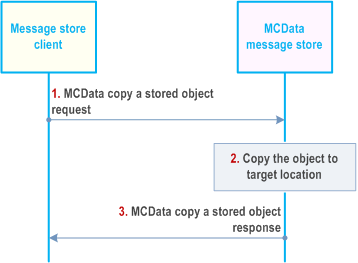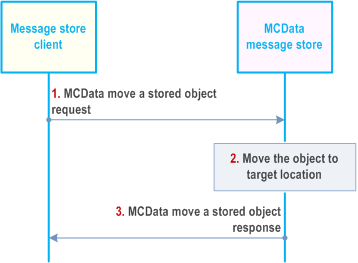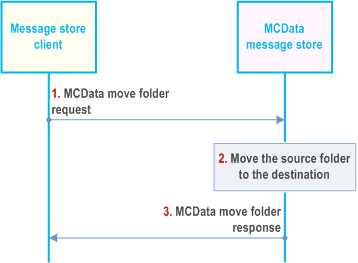Content for TS 23.282 Word version: 19.2.0
1…
5…
6…
6.6…
7…
7.4…
7.4.2.1.10…
7.4.2.2…
7.4.2.5…
7.4.2.8…
7.4.3…
7.5…
7.5.2.1.12…
7.5.2.2…
7.5.2.4…
7.5.2.6…
7.5.2.8…
7.5.2.11…
7.5.2.14…
7.5.3…
7.6
7.7…
7.7.2.1.13…
7.7.2.2…
7.8…
7.9…
7.13…
7.13.3.1.19…
7.13.3.2…
7.13.3.8…
7.13.3.16…
7.13.4…
7.14…
7.14.2.2…
7.17…
7.17.2.13…
7.17.3…
7.17.3.1.4…
7.17.3.2…
7.17.3.2.4…
7.17.3.2.6…
7.17.4…
7.17.6…
A…
B…
7.13.3.8 Deposit an object
7.13.3.9 Copy a stored object
7.13.3.10 Move a stored object
7.13.3.11 Folder create operation
7.13.3.12 Folder delete operation
7.13.3.13 Folder copy operation
7.13.3.14 Folder move operation
7.13.3.15 Folder list operation
...
...
7.13.3.8 Deposit an object p. 187
7.13.3.8.1 General p. 187
MCData server needs to store the communication information (i.e. an object) for a MCData user during an active MCData communication. If there is a file URL in the object for file distribution in the communication, the MCData server may instruct the MCData message store to retrieve a copy of the file to store locally in the MCData user's account.
7.13.3.8.2 Procedure p. 187
The procedure in Figure 7.13.3.8.2-1 describes how the MCData server deposit an object into the MCData message store during an active MCData communication.
Pre-conditions:
- A successful authentication and authorization has been performed between the MCData server and the MCData message store.
- The MCData user has been allocated a secured storage area in the MCData message store.
- The configuration to store the MCData communication in MCData message store is enabled for the MCData user.
- MCData user has requested to store his MCData communication and also store the distributed file content into his MCData message store account if the MCData communication is for file distribution through URL.

Step 1.
The MCData server would like to deposit a MCData communication information (i.e. object) to the MCData user's storage area in the MCData message store and initiates a MCData deposit an object request toward the MCData message store. The object is constructed by the MCData server and is included in the request. If the object is a message that carries a URL for file distribution, the MCData server may instruct the MCData message store to retrieve a copy of the file and store locally in the MCData user's account by setting the retrieve file indication information element to true.
Step 2.
The MCData message store deposits the object into the MCData user's storage area. If the retrieve file indication is set in the MCData deposit an object request the MCData message store retrieves the file URL from the stored object and fetches the file content from the MCData content server.
Step 3.
The MCData message store stores the file content into the MCData user's storage area and update the object with the URL referencing the file content stored in the MCData user's storage area.
Step 4.
The MCData message store communicates the result back to the MCData server in the MCData deposit an object response. The object identifier of the stored object is returned.
7.13.3.9 Copy a stored object p. 188
7.13.3.9.1 General p. 188
A stored object in the MCData message store can be copied to another location (i.e. folder) in the same MCData user account where there is no such object stored. After the successful object copy operation, the object will exist in both the original and destination locations. This operation is only meaningful when the user account in the MCData message store is structured in the folder hierarchy.
7.13.3.9.2 Procedure p. 188
The procedure in Figure 7.13.3.9.2-1 describes the case when a stored object is copied to a different location in the same MCData user account.
Pre-conditions:
- The MCData user has an account in the MCData message store.
- A successful authentication and authorization have been performed between the message store client and the MCData message store.
- The message store client knows the object identifier of the stored object and the destination folder identifier.

Step 1.
The message store client would like to copy a stored object in the MCData message store to a destination folder and initiates a MCData copy a stored object request toward the MCData message store. The uniqe identifier of the stored object and the destination folder are included in the request.
Step 2.
The MCData message store copies the object to the target location.
Step 3.
The MCData message store returns the result of the request in the MCData copy a stored object response.
7.13.3.10 Move a stored object p. 189
7.13.3.10.1 General p. 189
A stored object in the MCData message store can be moved to a different location (i.e. folder) in the same MCData user account. After the successful object move operation the object will only exist in the new location. This operation is only meaningful when the user account in the MCData message store is structured in the folder hierarchy.
7.13.3.10.2 Procedure p. 189
The procedure in Figure 7.13.3.10.2-1 describes the case when a stored object is moved to a different location in the same MCData user account.
Pre-conditions:
- The MCData user has an account in the MCData message store.
- A successful authentication and authorization have been performed between the message store client and the MCData message store.
- The message store client knows the object identifier of the stored object and the destination folder identifier.

Step 1.
The message store client would like to move a stored object in the MCData message store to a destination folder and initiates a MCData move a stored object request toward the MCData message store. The uniqe object identifier of the stored object and the destination folder are included in the request.
Step 2.
The MCData message store moves the object to the target location.
Step 3.
The MCData message store returns the result of the request in the MCData move a stored object response.
7.13.3.11 Folder create operation p. 190
7.13.3.11.1 General p. 190
A user can create a new folder in his user account n the MCData message store. This operation is only meaningful when the user account in the MCData message store is structured in the folder hierarchy.
7.13.3.11.2 Procedure p. 190
The procedure in Figure 7.13.3.11.2-1 describes the case when a MCData user creates a new folder in the MCData message store.
Pre-conditions:
- The MCData user has an account in the MCData message store.
- A successful authentication and authorization have been performed between the message store client and the MCData message store.

Step 1.
The MCData user would like to create a new folder in his user account in the MCData message store, the message store client initiates a MCData create folder request toward the MCData message store. The parent folder identifier and the folder name are included in the request to indicate where the new folder will be created.
Step 2.
The MCData message store creates the user folder in the location specified in the request. If the folder name is provided in the request, the MCData message store creates the folder with the provided folder name. If the provided folder name has a conflict or no folder name is provided in the request, the MCData message store assigns a name for the new user folder.
Step 3.
The MCData message store returns the result in the MCData create folder response. The identifier of the new folder is returned in the response.
7.13.3.12 Folder delete operation p. 191
7.13.3.12.1 General p. 191
A user can delete an existing folder in his user account in the MCData message store. All the child folders and objects stored in that folder will be deleted. This operation is only meaningful when the user account in the MCData message store is structured in the folder hierarchy.
7.13.3.12.2 Procedure p. 191
The procedure in Figure 7.13.3.12.2-1 describes the case when a MCData user deletes an existing folder in the MCData message store.
Pre-conditions:
- The MCData user has an account in the MCData message store.
- A successful authentication and authorization have been performed between the message store client and the MCData message store.

Step 1.
The MCData user would like to delete an existing folder in his user account in the MCData message store, the message store client initiates a MCData delete folder request toward the MCData message store. The folder identifier of the folder to be deleted is included in the request.
Step 2.
The MCData message store identifies the target folder and deletes it from the user account. All the child folders and objects stored in this folder are also deleted.
Step 3.
The MCData message store returns the result in the MCData delete folder response.
7.13.3.13 Folder copy operation p. 192
7.13.3.13.1 General p. 192
A user can copy an existing folder in his user account to a different location. All the child folders and objects stored in that folder will be copied to the new folder. The name of the new folder will be the same as the folder it copies from or the name provided in the request. This operation is only meaningful when the user account in the MCData message store is structured in the folder hierarchy.
7.13.3.13.2 Procedure p. 192
The procedure in Figure 7.13.3.13.2-1 describes the case when a MCData user copies an existing folder in the MCData message store.
Pre-conditions:
- The MCData user has an account in the MCData message store.
- A successful authentication and authorization have been performed between the message store client and the MCData message store.

Step 1.
The MCData user would like to copy an existing folder in his user account in the MCData message store, the message store client initiates a MCData copy folder request toward the MCData message store. The folder identifiers of the source and destination folders and the new folder name are included in the request.
Step 2.
The MCData message store copy the source folder to the destination with the new folder name. If no new folder name is provided in the request, the source folder name will be used. All the child folders and objects stored in this folder are also copied to the new folder.
Step 3.
The MCData message store returns the result in the MCData copy folder response. The identifier of the new folder is returned in the response.
7.13.3.14 Folder move operation p. 193
7.13.3.14.1 General p. 193
A user can move an existing folder in his user account to a different location. All the child folders and objects stored in that folder will be moved to the new folder. The name of the new folder will be the same as the folder it moves from or the name provided in the request. This operation is only meaningful when the user account in the MCData message store is structured in the folder hierarchy.
7.13.3.14.2 Procedure p. 193
The procedure in Figure 7.13.3.14.2-1 describes the case when a MCData user moves an existing folder in the MCData message store.
Pre-conditions:
- The MCData user has an account in the MCData message store.
- A successful authentication and authorization have been performed between the message store client and the MCData message store.

Step 1.
The MCData user would like to move an existing folder in his user account in the MCData message store to a new location, the message store client initiates a MCData move folder request toward the MCData message store. The folder identifiers of the source and destination folders and the new folder name are included in the request.
Step 2.
The MCData message store move the source folder to the destination with the new folder name. If no new folder name is provided in the request, the source folder name will be used. All the child folders and objects stored in this folder are also moved to the new folder.
Step 3.
The MCData message store returns the result in the MCData move folder response. The identifier of the new folder is returned in the response.
7.13.3.15 Folder list operation p. 194
7.13.3.15.1 General p. 194
A user can view the folder structure in his user account in the MCData message store. The target folder hierarchy structure will be presented to the user; i.e. the folder and all its child folders. This operation is only meaningful when the user account in the MCData message store is structured in the folder hierarchy.
7.13.3.15.2 Procedure p. 194
The procedure in Figure 7.13.3.15.2-1 describes the case when a MCData user lists an existing folder's hierarchy structure in the MCData message store.
Pre-conditions:
- The MCData user has an account in the MCData message store.
- A successful authentication and authorization have been performed between the message store client and the MCData message store.

Step 1.
The MCData user would like to view the folder strcture of a targeted folder in his user account in the MCData message store, the message store client initiates a MCData list folder request toward the MCData message store. The folder identifier of the target folder is included in the request.
Step 2.
The MCData message store retrieves the target folder and all its child folders. If no target folder name is provided in the request, the MCData message store will use the root folder as the target folder.
Step 3.
The MCData message store returns the result in the MCData list folder response.